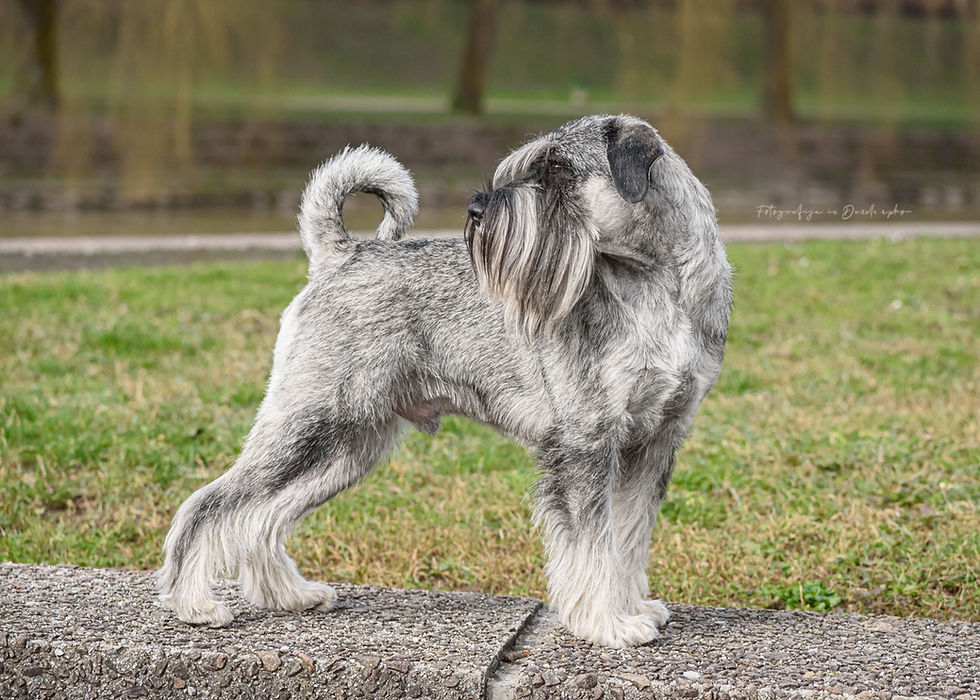HAND-STRIPPING OR CLIPPING
- Lucka Zabkar

- Jun 6
- 3 min read
Updated: Jul 30
💅 Introduction
Proper coat care is a fundamental part of caring for a Schnauzer – not only for aesthetic reasons, but more importantly, for the dog's comfort, health, and protection from environmental conditions. While the breed standards clearly define what the ideal coat should look and feel like, we are increasingly seeing dogs whose coat quality significantly deviates from these expectations.
In this article, I summarize my long-term observations from grooming my dogs, valuable insights from conversations with breeders and professional groomers, and, most importantly, highlight the responsibility that comes with choosing between hand-stripping (trimming) and clipping. This is not a matter of fashion or personal taste – it is about what is proper, kind, and safe for each dog.
Personal experience
I am not a professional groomer, but I have been successfully grooming my Schnauzers for many years. Fortunately, they have excellent coats – hard, wiry, close-fitting, with a good balance of undercoat and topcoat. Due to this ideal texture and classic salt-and-pepper coloring, I have become a passionate advocate of the rolling coat method and have long encouraged other owners to use this effective technique to maintain the best possible coat quality.

That said, my practical experience is limited to a relatively small number of Schnauzers and is therefore somewhat biased. Still, my eye and touch are trained enough to assess whether a coat is suitable or not, and I adapt my grooming accordingly.
What the standard says – and what we see in practice
More and more often, I observe dogs (least commonly medium Schnauzers) whose coats do not match the FCI standards No. 181, 182, and 183:
The coat should be wiry, harsh, and dense. It consists of a dense undercoat and a not-too-short topcoat, lying close to the body. The topcoat is rough and sufficiently long to allow the checking of its texture; it is neither bristly nor wavy. Hair on the limbs tends to be less harsh. Coat short on the forehead and ears. Typical characteristics are the not-too-soft beard on the muzzle and the bushy eyebrows, which slightly shade the eyes.
Unfortunately, more and more Schnauzers are showing atypical coats, such as:
• excessive undercoat, which prevents new hair follicles from forming – without which new topcoat hairs cannot grow;
• topcoat that does not enter the natural shedding phases (telogen – resting; exogen – shedding and new growth);
• soft, loose, wavy hair that does not lie flat;
• a coat that continues to grow abnormally and cannot be hand-stripped without causing discomfort.
All of these factors pose a serious problem – not only for the dog's appearance, but more importantly for its comfort, coat health, and the long-term preservation of the breed's typical traits.
What makes a good coat, and how to maintain it
A good coat is not only beautiful and functional (repelling dirt and moisture and protecting the dog from heat or cold), but is also relatively easy to maintain:
• by maintaining the right amount of undercoat (dense but short), achieved through regular carding with an appropriate stripping knife;
• and by hand-stripping mature topcoat hairs that have reached the end of their growth cycle – these can be removed painlessly by hand or with tools such as non-cutting knives, metal sticks, volcanic stones, and so on.
But what if the coat is too long, soft, and cannot be pulled without causing pain? Then it is probably not suitable for stripping. Imagine someone pulling your hair out by force – it would hurt. That's precisely what the dog feels. Sadly, due to ignorance or excessive ambition, some owners still demand hand-stripping, and groomers, either inexperienced or indifferent, comply. The dog pays a high and painful price, with little or no benefit.
Making the responsible choice
I recently discussed this issue with experienced breeders and groomers who are well-versed in the Schnauzer breed. The conclusion is clear: Schnauzers with poor coat quality that cannot be hand-stripped without pain should not be stripped at all. These dogs need regular and frequent carding (especially since their undercoat is often too thick), and any existing topcoat should be shortened with scissors or clippers if it continues to grow.
Unfortunately, atypical coats are becoming increasingly common. And when a coat cannot be "corrected" or maintained through the stripping method, owners must accept that, in these cases, the question of hand-stripping or clipping is no longer relevant. Stripping is simply not an option.
✅ Conclusion
Every Schnauzer deserves coat care that respects its coat type and prioritizes its comfort. Stripping a dog with an unsuitable coat, causing pain and no real benefit, is not breed preservation – it is a form of neglect.
Understanding coat types, realistic grooming expectations, and above all, prioritizing the dog's well-being, are the cornerstones of responsible grooming decisions.
When the coat cannot be improved or shaped using the stripping approach, clipping is not a defeat – it is a responsible choice.



Comments